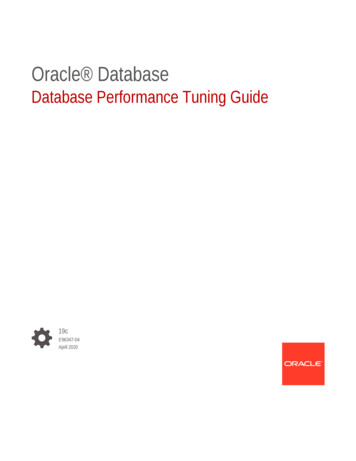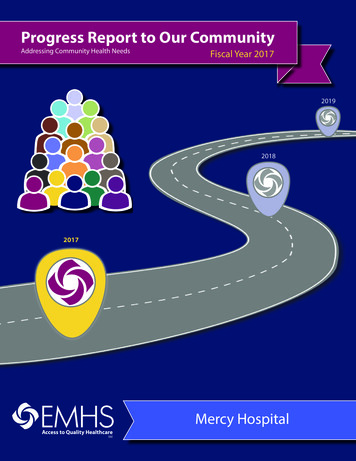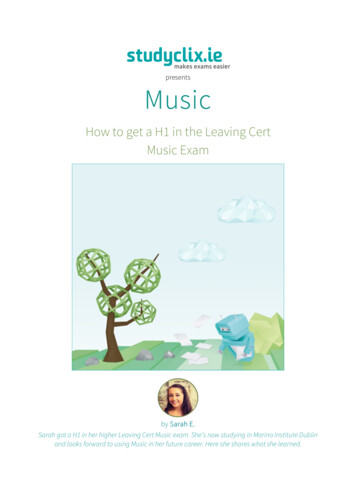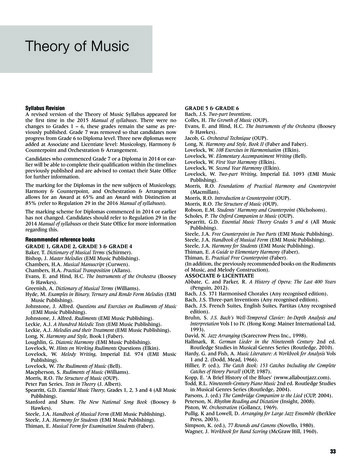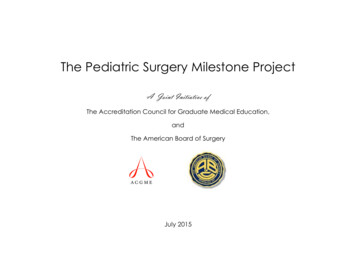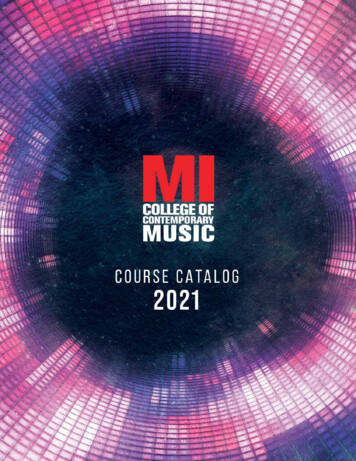
Transcription
Project milestone: Generating music with Machine LearningDavid KangStanforddwkangJung Youn KimStanfordjyk423Simen RingdahlStanfordringdahlAbstractComposing music is a very interesting challenge that tests the composer’s creative capacity, whether ita human or a computer. Although there have been many arguments on the matter, almost all of musicis some regurgitation or alteration of a sonic idea created before. Thus, with enough data and the correctalgorithm, machine learning should be able to make music that would sound human. This report outlinesvarious approaches to music composition through Naive Bayes and Neural Network models, and althoughthere were some mixed results by the model, it is evident that musical ideas can be gleaned from thesealgorithms in hopes of making a new piece of music.1Introduction2This report will explore the various ways in which a computer can be taught to generate music. Having learningalgorithms as a creative aid will offer great help for thoseseeking inspiration and innovation in their music writing.This report will be approaching music generation in fourways: one through a simple Naive Bayes algorithm andthe others through neural networks, specifically a vanillaneural network, an LSTM RNN, and an encoder-decodermodel RNN. For each algorithm, we will utilize differentapproaches to data organization and music creation. TheNaive Bayes and the vanilla neural network will organizethe notes temporally, where a song is outlined by the specific time interval in which a note is played as each notewill have a start and end time within a given piece. For theLSTM model, a song will be outlined based by new noteevents, where every time there’s a new note, a new vectoris created. The model also takes in one note at a timeand outputs one note at a time. For the encoder-decodermodel, the song will be organized by chords, where a songconsists of just a series of chords with varying lengths.Moreover, the encoder-decoder model will take as input asequence of notes and output a sequence of notes.1.1Related workThere have been many attempts to make music using machine learning. One of the first attempts, made use ofMarkov Chains, and transition matrices that define theprobabilities of certain notes being produced. This workwas carried out by Iannis Xenakis (20) The early successful works in this field began by looking at sequences, tryingto predict the note played at some point n 1 using all npoints. Peter Todd (17) was among the first at this.In the past few years, there has been an increased interest in machine-learning-created music. Ranging fromAIVA (1) which focuses on making complete soundtracksusing AI, to the Magenta research project (11) whichtouches of many different aspects of music production.In addition to these rather large scale projects on music, the more successful approaches in music creation havebeen results of neural networks. There have been smallerprojects looking particularly at the MIDI-build up of music. Daniel Johnson managed to make a simple piece ofmusic using a specially designed recurrent neural network(RNN) (7), and RNNs have repeatedly been shown to givegood and useful results in music generation. Drawinginspiration from these works, we will also apply RNNalgorithms to model sequences of music.Moreover, a recent Transformer model has done verywell in creating music that most resembles actual humanperformance. A recent study by Huang et al. (2018) (6)utilized data that took into account the velocity the notesbeing played along with using models along with using asequence model with self-attention to best maintain themedium-term memory that exists in music.There have been far fewer attempts at making musicusing classification algorithms such as Naive Bayes, andthey show variable results. The approach is usually combined with numerous strong assumptions and is thus notnecessarily as versatile as the RNNs. (10)Problem definitionsThe input to our algorithm will be a note or a series ofnotes from a MIDI file. We then use a Neural Network,Recurrent Neural Network, an Encoder and Decoder Recurrent Neural Network, and a Naive Bayes approach togenerate a new sequence of notes with the aim of makinga good piece of music.To test how successful the music generation is from theneural networks, we will evaluate the prediction of thenext note against the actual next note as a percentagescore. For the Naive Bayes approach, however, we willcompare the generated music to a random (flat) distribution of notes. We will therefore need to ask peoples3 Dataset and featuresopinions on to what extend our model improved the quality of the music. This is a slightly unscientific approach We had two main ways of obtaining data for our processof evaluating music, but then again, that is the nature of ing. The first was to use free downloaded files of MIDImusic and then use music21 (4) to decompose the files. Formusic.the encoder-decoder model that we’ve implemented, wefocused on mainly classical piano music from the websitewww.piano-midi.de/ because of the availability of MIDI1
files for classical music and the fact that the music forclassical music is more standardized than that of anothergenre. Piano works from a variety of different composerssuch as Bach, Brahms, Beethoven, and Mozart were usedfor a total of 771 songs. We processed all the MIDI filesusing the music21 Python package (4), and for MATLABwe used a similar written package (15). Each song wasconverted into a collection of chords, where all the noteswere ”chordified” or in other words compressed into a single chord for each time step. In other words, at everynew note event (i.e. a new note was played), a new chordwill be created to result in that change. Moreover, eachchord was represented as a multi-hot vector of length 219.128 for the number of possible of MIDI notes, 64 for theFigure 2: Matrix representation of LSTM Model datapossible pitch duration which was derived from the givendata, 8 for the possible numerators of the time signature,4 for the possible denominators of the time signature, and15 for the possible key signature (represented as numberof flats, positive or negative). Thus, a song might consistof 5000 chords with varying note duration, which is our”note” representation as previously mentioned contrastedto the temporal representation. A total of around 700songs were used for a total of around 400,000 notes, and astandard 80-10-10 training-validation-test split was used.For the LSTM model, the dataset consisted of 24 of Romantic composer Frederic Chopin’s etudes from https://www.classicalarchives.com/ for a total of 57 minutesand 25 seconds of music and 22,290 notes. Due to thestructure of piano music, we decided to process notes (orFigure 3: A MIDI-file played in Synthesiachords if there were multiple notes) and rhythms of thefig. 3 shows a screenshot from a video of a very popularboth the left and right hand at each time stamp to trainpiano software Synthesia (16) playing a MIDI-file as if itour model.were being played on a real piano. The piano keys changecolor when a particular note is played, and usually, theright and left hand notes are colored differently. Thesevideos can range from single 3 minute songs to hour-longvideos with for example Pirates of the Caribbean film music. We therefore made a program which downloads andlooks through these videos and generates an array withthe notes played and at what times and their duration.This proved to be a working way to gather data on muchmore recent music, which might not have MIDI files readily available to the public. This data will give us the keyFigure 1: Beethoven’s Fifth Symphony music sheetpressed, expressed as an integer ranging from 1 to 88 representing the number of keys on the piano in order fromFor example, in fig. 1, the data from (1) would be rep- lowest frequency to highest frequency, and it is organizedresented by the vector [‘C5’, 1.0, ‘B-3.D4’, 2.0], where the temporally by the start and end time of when the notefirst two entries refer to the notes played by the right hand was pressed.and their duration while the other two entries refer to thatMethodsof the left hand. If only one hand is playing at a time as 4in (2), it would correspond with an entry with a None As outlined previously, we have utilized four models ofinstance. Thus, (2) would be represented as [‘C5’, 1.0, Naive Bayes, vanilla neural network, LSTM RNN, andNone, None]. Thus, a song would consist of a series of the encoder decoder RNN.these vectors for each note event. Then a dictionary wascreated to enable one-hot encoding for each of the unique 4.1 Naive Bayes-likevectors. Therefore, as seen in fig. 2, our data consists of We have named this a Naive-Bayes like approach as onlya three dimensional matrix with the height corresponding uses some of the fundamentals from the Naive Bayes weto each song, width corresponding to the one hot vector know. In this algorithm we look at each press of a noteof note incident, and the length corresponding to the the as an independent variable (even though we know thattime stamp of the note incident.they are not). The purpose of this model is to make aAggregating non-classical music for the Naive Bayes and distribution for which keys are pressed for a given chord.neural network model proved to be difficult for various Therefore, this algorithm will consist of two parts:different reasons ranging from copyright issues to general1. Classify Chords: This was achieved by lookingavailability. Thus, we have referred to another method forat the notes played by the left hand on a piano.collecting data.2
We made a program that makes a dictionary of all the current cell state. For the next step corresponding tothe unique combinations of three consecutive notes the middle part of the diagram, the input gate layer deplayed by the left hand.1noted by i(t) combined with the new candidate values g(t)decide what part of the input will be updated into the cur2. Classify notes: Now that we know the chords in rent cell. To actually update the cell state, the cell statea song, the program will run through many pieces from the previous time step is multiplied by the output ofof music and find which notes were played by the the forget gate and then is added to the input gate. Thisright hand for a given chord in the dictionary. After corresponds to the horizontal line in the top of the centermultiple songs, we have generated a comprehensive diagram and is noted by c in the equations. Lastly, the(t)distribution of P (note chord).actual output and the hidden state for the current timestep is denoted by y(t) , which is a result of a tanh layer4.2 Neural Networksfrom our cell state and a sigmoid layer from our input andWe implemented a basic neural network (NN) for pattern previous hidden state.recognition in music generation. Using a similar methodto predicting the next word typed by a user in a text pro- 4.4 Encoder-Decoder (Seq2seq)gram, we wanted to predict the next note played in thesequence. Therefore we gave the NN a vector representation of the previous note played, its key signature, thestart and duration of the note, as well as the previous 100notes played; a total of 104 entries. We fed this into aneural network with 1024 neurons and asked it to predictthe most likely note played among the 88 different possibilities. As we will see in the next methods, there is nodirect memory component with this neural network, buthaving the previous 100 notes as inputs serves as a proxyto the memory methods in the subsequent methods.4.3LSTMFigure 5: Encoder-Decoder Model DiagramTo further explore the RNN architecture, we have alsoimplemented the encoder-decoder model that is often usedin Natural Language Processing (2). While still in essencean RNN, the main difference is that it is a many to manymodel. In other words, this is a model that takes in asequence of data and outputs a sequence of data. Theencoder takes in the input and ”translates” it through thedecoder for an output. Moreover, instead of focusing ona very long term memory, the memory of the algorithmis limited to the sequence that we feed into it (100 notesin this case). We have also used GRU layers instead ofLSTM layers.Figure 4: LSTM Structure Diagram (12)The most popular method for music generation, theLSTM helps us solve the problem of the regular neuralnetwork lacking ”memory” or knowing how to relate orfigure out data sequentially. The main features of theLSTM RNN compared to the regular RNN are the intput, output, and forget gates. (5)z σ (xt U z st 1 W z )r σ (xt U r st 1 W r )h tanh xt U h (st 1 r) W h st (1 z) h z st 1TTi(t) σ(Wxi· x(t) Whi· h(t 1) bi )The GRU and LSTM models are similar, except thatthe GRU has a reset (r) and an update gate (z) insteadof the input, output, and forget gates of the LSTM. Theforget and input gate are combined into a single updategate while the reset gate determines how to combine previous memory with the new input. In terms of overallstructure, they are very similar, but the GRU is a muchsimpler model than the LSTM and has shown to be quickerto train (12).Moreover, we used the approach of having each song bea collection of notes. Thus, compared to the Naive Bayesmodel, the data is not discretized by time, and unlikethe LSTM model, the data is not organized by new noteevents. We will also use more features compared to theLSTM model as the data will include information aboutkey signature and time signature. Although it is likelythat the neural networks will be able to learn the ideas ofTTf(t) σ(Wxf· x(t) Whf· h(t 1) bf )TTo(t) σ(Wxo· x(t) Who· h(t 1) bo )TTg(t) tanh(Wxg· x(t) Whg· h(t 1) bg )c(t) f(t) c(t 1) i(t) g(t)y(t) h(t) o(t) tanh(c(t) )Corresponding to the leftmost part of the center diagram in fig. 4, the first step of the LSTM is to decide whatparts of the previous information will be forgotten. Thiscorresponds to the forget gate denoted by f(t) . It takesin inputs from the previous hidden state and the currentinput to combine with the previous cell state to produce1 This may sound like many combinations, but in fact many modern songs can get away with just four different combinations. (19)3
we have completely ignored the fact that more keys areplayed at the same time, which results in a bigger errorfor the model. If we would continue this project further,then this would have been an important area of focus.To qualitatively assess the the music itself, we conducted a music Turing test survey. We let survey participants decide whether or not each generated piece ofmusic by the algorithm sounded human or computer generated. We also asked participants what they thought ofthe composing complexity of each song. 47% of particiFigure 6: GRU Model Diagram(3)pants thought that the music was human generated while53% of participants thought that the composing level waskey and time signature on its own with out the data, we intermediate or advance. This is likely due to the modelhave included it in the feature space to see if there were overfitting on the original song, which resulted in a songthat sounds familiar with the original song with a few difany different results in the ble 1: Results for all the modelsModelTrain LossTest LossNaive Bayes 22.1% (Pred) 3.18% (Pred)Vanilla NN .01904 (CE) .1260 (CE)LSTM.5345 (CE).7986 (CE)Enc-Dec .04473 (BCE) .06773 (BCE)47%,47%,36%,23%,93%53%89%30%Sample size is # of notes. Turing Test is % guessed human, %perceived as intermediate/advanced composing level. All models had15 survey responses5.1Naive BayesTo test this model, we chose music with comparatively fewutilized chords. Virginia which had close to 5,000 notesthrough the song showed a total of 40 different combinations of left hand progressions, with four of these beingvery over-represented. These are the four chords that arerepeated over the entire song. After making the distribution over the notes, we generated a new song where foreach chord in the song the algorithm would pick notesfrom the probability distribution. To test the accuracy ofthis model, we compared the predicted key signature ofthe note to the actual key signature, and we could obtainan accuracy of over 20 %. However, the point of this algorithm is to consider the harmony of the generated music.This song sounded ”better” in the form that we could hearthe harmony a lot clearer, a lot more than we would seein a flat distribution. In our survey results, 47% of participants thought that the music was human generated.93% of participants thought that the composing level wasintermediate or advanced. This is again likely due to theoverfitting of the model.Sample Size Turing Test10,57010,57022,290408,7005.2Vanilla Neural NetworkWe downloaded a Pirates of the Caribbean (9) film music compilation and found it had close to 10,000 notesplayed. Feeding this through our artificial neural network(hilariously termed Depplearning for the occasion), it wastrained over 115 iterations. Using 15% of the data for validation and 15% for testing, the neural network showedthe following development:5.3LSTMOur LSTM model was implemented on NumPy (13) resembling an implementation from Navjinder Virdee (18)and consists of a single LSTM layer with 256 hidden neurons. The result of this layer is then passed into a softmaxlayer for the final output. Loss was calculated throughcross entropy, and the algorithm was optimized using theAdam algorithm (8) with a .005 learning rate, β1 .9,and β2 .999.Figure 7: Neural network performance on a dataset withca. 10,000 values, with 1024 neurons.The network showed a 5% error on the training set, buta 88% error on the test set, which is a sign of overfitting.When using the network to make music, we heard that thesame notes were repeated unnaturally many times, andthe song had no weight on harmony. It is as if the networkgives up in finding any pattern, and instead returns themost played note in the selection.Figure 8: LSTM Model LossThe way we would generate the song after havingtrained the network is to keep the timings (start timeand duration) of the original notes in the song, and thenThe training and evaluation loss dropped substantiallyonly change the note played. This further means that in a similar pattern in first 20 epochs and finished at4
around .5345 and .8297 respectively after 100 epochs. Inparallel, the average test loss was approximately .7986.Looking at the resulting sheet music from the algorithm,qualitatively, it is very difficult to determine whether ornot the music was generated through an algorithm.Figure 10: Encoder Decoder Model Average LossFigure 9: Music Generated from LSTM Algorithmof notes from the test set. Although there are hints of harmonic progression in the music, it is very clear that themusic is not human generated. In our survey results, only23% of the participants thought that the music was human generated and only 30% thought that the composinglevel of the music was intermediate or advanced.Although there seems to be repetitions of certainmelodies, the notes were slightly offset, so they are notexactly similar. With regards to the survey results, theLSTM model had the most interesting results. Only 36%of participants thought that the music was human generated, but 89% thought that the composing level wasintermediate or advanced. Also, most people commentedthat they were able to distinguish the generated music because it was lack of dynamics. From what we gather, thisindicates that the people thought that the music was relatively complex and coherent with typical musical motifs,harmonies, and melodies, but the music lacked a certainhuman quality. It would be interesting to study in futurework what qualities in music lead people to think it to bemore human.5.4Figure 11: Encoder Decoder Model Generated MusicEncoder DecoderThe encoder-decoder model was implemented on Pytorch(14). Batch size of around 100 chords was used, which isaround 40 measures or so in a typical song. The Encoderand Decoder both consist of two GRUs with 512 hiddenneurons each followed by a dropout layer with .5 drop rateto prevent overfitting. However, the decoder model usesteacher forcing with rate .5 to aid and speed up training.The output of the last dropout layer in the decoder is thenpassed through a linear and a sigmoid layer that outputsthe probability of each the occurrence of each pitch value,note duration, time and key signature.Loss was calculated through binary cross entropy loss,where both the beginning of sequence and end of sequencetokens were removed to have sensible calculations. The algorithm was optimized by the Adam algorithm (8) with alearning rate of 1e 5. The low learning rate and gradient clipping was utilized because we experienced explodinggradients in testing our algorithm.The average training loss went down significantlythroughout the epochs and lingered around .04473, butthe average evaluation loss plateaued rather quickly andslowly started to increase in later epochs, hovering around.7212. This was closely aligned to the average test loss at.6773. The initial dip in the evaluation loss shows thatthe algorithm did learn a little bit, but the plateau indicates that there was a rather quick peak in how much thealgorithm could learn, and running more epochs wouldonly result in over-fitting. The middling evaluation lossis evident in the music, which consists of very repetitivesounding notes. Music was created by feeding sequencesThere are two possible causes for such mediocre performance on songs generated by the encoder decoder model.The first is data structure. Because a single note changeindicates a new chord, often times, the notes generallyseem as if they are repeating with minute differences eachtime, which is reflective in the generated music. The second is the small batch size. While 100 notes seem likea very sizable amount (it is around 40 or so measures),for high tempo frenetic songs with many minute changes,there might be high variability in how long these sequencesare temporally. Thus, a thing to try in future attempts isto change the batch size for longer term memory.6Conclusion/Future WorkIn conclusion, among the four algorithms that we tested,the LSTM RNN model performed the best. Coupledwith organizing the data through new note incidents, theLSTM model was able to string together musical motifs with coherent melody and harmony. Although NaiveBayes and the Neural Network produced very musicalideas in song, it was largely due to over-fitting the data.For the encoder model, due to the discretization of thedata, most of its results were very repetitive notes thatmade some harmonic sense but was mostly unmusical.In the future, with more time, it would be interesting toexplore more memory focused models such as the transformer model while also incorporating note velocity fromhuman recorded MIDI files to bring more life into the generated music.5
7ContributionsOlah, C. (n.d.). Understanding lstm networks. Retrieved from -LSTMs/With regards to the models, Simen worked on the NaiveBayes and the vanilla neural network; Jay worked on theLSTM RNN; and David worked on the encoder-decodermodel. Simen did majority of the work in constructingthe poster and writing up the outline and milestone whileDavid helped synthesize the write up/final report. Jayconducted the survey on generated music and accumulated the results.8Oliphant, T. (2006). NumPy: A guide to NumPy. USA:Trelgol Publishing. Retrieved from http://www.numpy.org/Paszke, A., Gross, S., Chintala, S., Chanan, G., Yang,E., DeVito, Z., . . . Lerer, A. (2017). Automatic differentiation in pytorch. In Nips-w.Code and MusicSchutte, K. (n.d.). Kenschutte.com. Retrieved fromhttp://kenschutte.com/midiAll code can be found in SE CSxnyp6bvaMQzZa?dl 0,and you can listen to our generated music in s://bit.ly/2zZSGgD.Synthesia.(n.d.).Synthesia, piano for everyone.http://synthesiagame.com/. Retrieved from http://synthesiagame.com/Todd, P., & Loy, D. (1991). Music and connectionism. MIT Press. Retrieved from https://books.google.com/books?id NxycaQH6PeoCReferencesAiva. (n.d.). https://www.aiva.ai/. Retrieved fromhttps://www.aiva.ai/Virdee, N.(n.d.).Retrieved from -network-from-scratch/notebookCho, K., van Merrienboer, B., Gülçehre, Ç., Bougares,F., Schwenk, H., & Bengio, Y. (2014). Learning phraserepresentations using RNN encoder-decoder for statistical machine translation. CoRR, abs/1406.1078 . Retrieved from http://arxiv.org/abs/1406.1078White, A. (2014, Apr). 73 songs you can play withthe same four chords. BuzzFeed. Retrieved u-can-play-with-the-same-four-chordsChung, J., Gülçehre, Ç., Cho, K., & Bengio, Y. (2014).Empirical evaluation of gated recurrent neural networkson sequence modeling. CoRR, abs/1412.3555 . Retrievedfrom http://arxiv.org/abs/1412.3555Xenakis, I. (1992). Formalized music : thought and mathematics in composition / iannis xenakis (Rev. ed. ed.)[Book]. Pendragon Press Stuyvesant, NY.Cuthbert, M. S., & Ariza, C. (n.d.). music21: A toolkitfor computer-aided musicology and symbolic music data.Géron, A. (2017). Hands-on machine learning withscikit-learn and tensorflow: Concepts, tools, and techniques to build intelligent systems. O’Reilly Media.Retrieved from https://books.google.com/books?id bRpYDgAAQBAJHuang, C.-Z. A., Vaswani, A., Uszkoreit, J., Shazeer, N.,Simon, I., Hawthorne, C., . . . Eck, D. (2018, September).Music Transformer. arXiv e-prints, arXiv:1809.04281.Johnston, D. (2015, Aug). Composing music with recurrent neural networks. Daniel Johnson. Retrieved -music-with-recurrent-neural-networks/Kingma, D. P., & Ba, J. (2014). Adam: A methodfor stochastic optimization. CoRR, abs/1412.6980 . Retrieved from http://arxiv.org/abs/1412.6980Landry, K. (2016, Jun). Pirates of the caribbean medley[piano tutorial] (synthesia) // kyle landry sheets/midi.YouTube. Retrieved from https://www.youtube.com/watch?v iddFrfC0YoULichtenwalter, R., Lichtenwalter, K., & Chawla, N.(2009, 01). Applying learning algorithms to music generation. In (p. 483-502).Magenta. (n.d.). https://magenta.tensorflow.org/.Retrieved from https://magenta.tensorflow.org/6
Project milestone: Generating music with Machine Learning David Kang Stanford dwkang Jung Youn Kim Stanford jyk423 Simen Ringdahl Stanford ringdahl Abstract Composing music is a very interesting challenge that tests the composer’s creative capacity, whether it a human or a computer.
